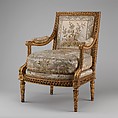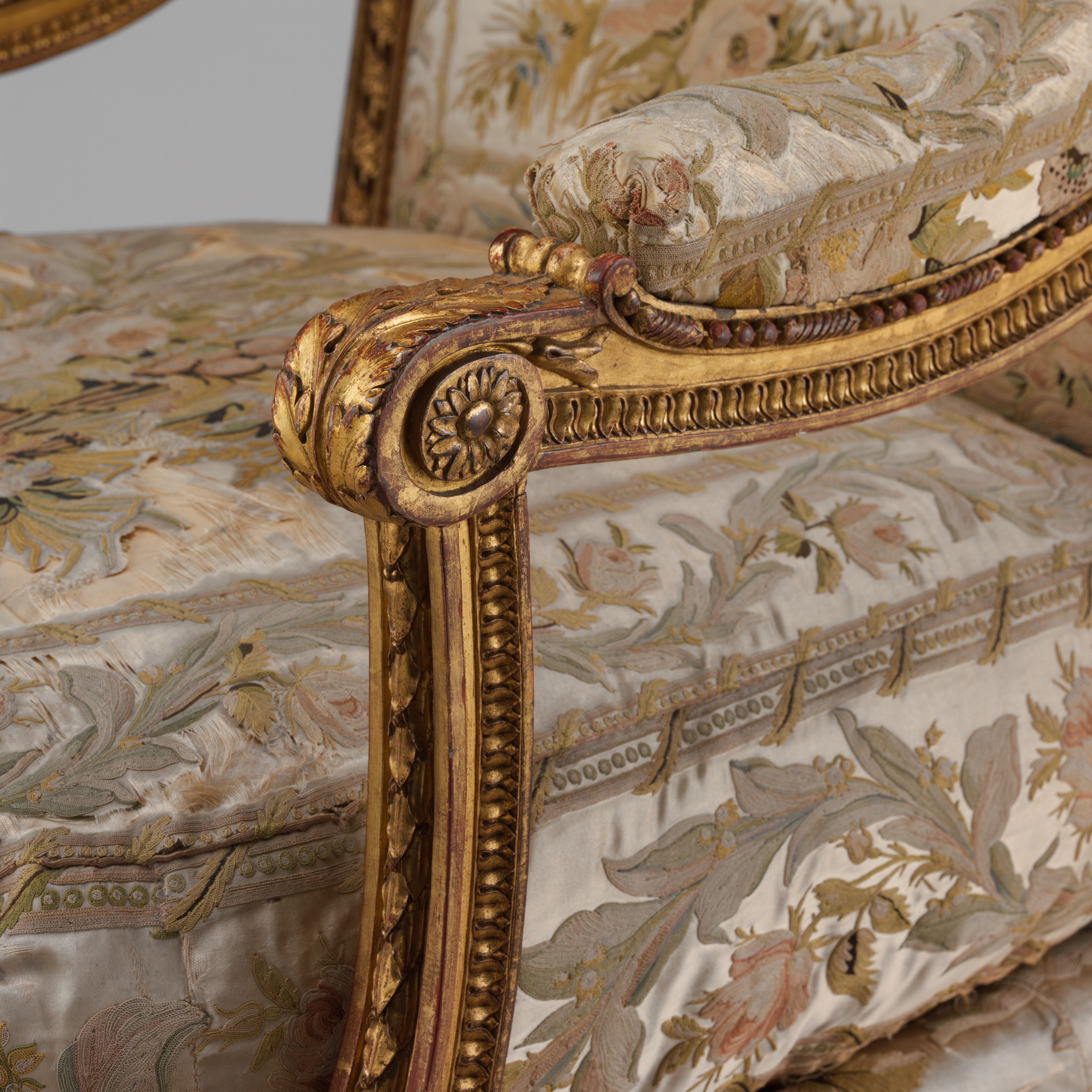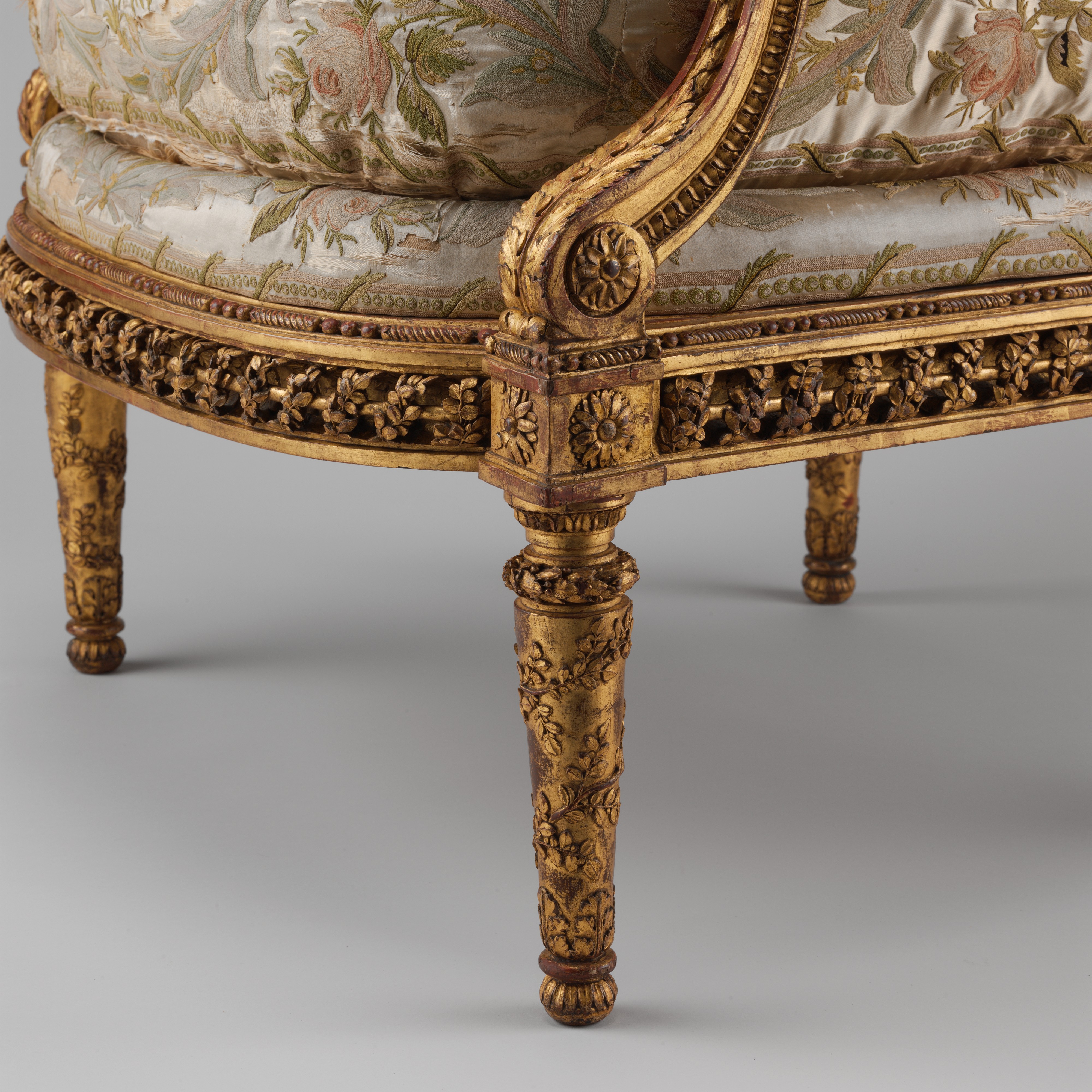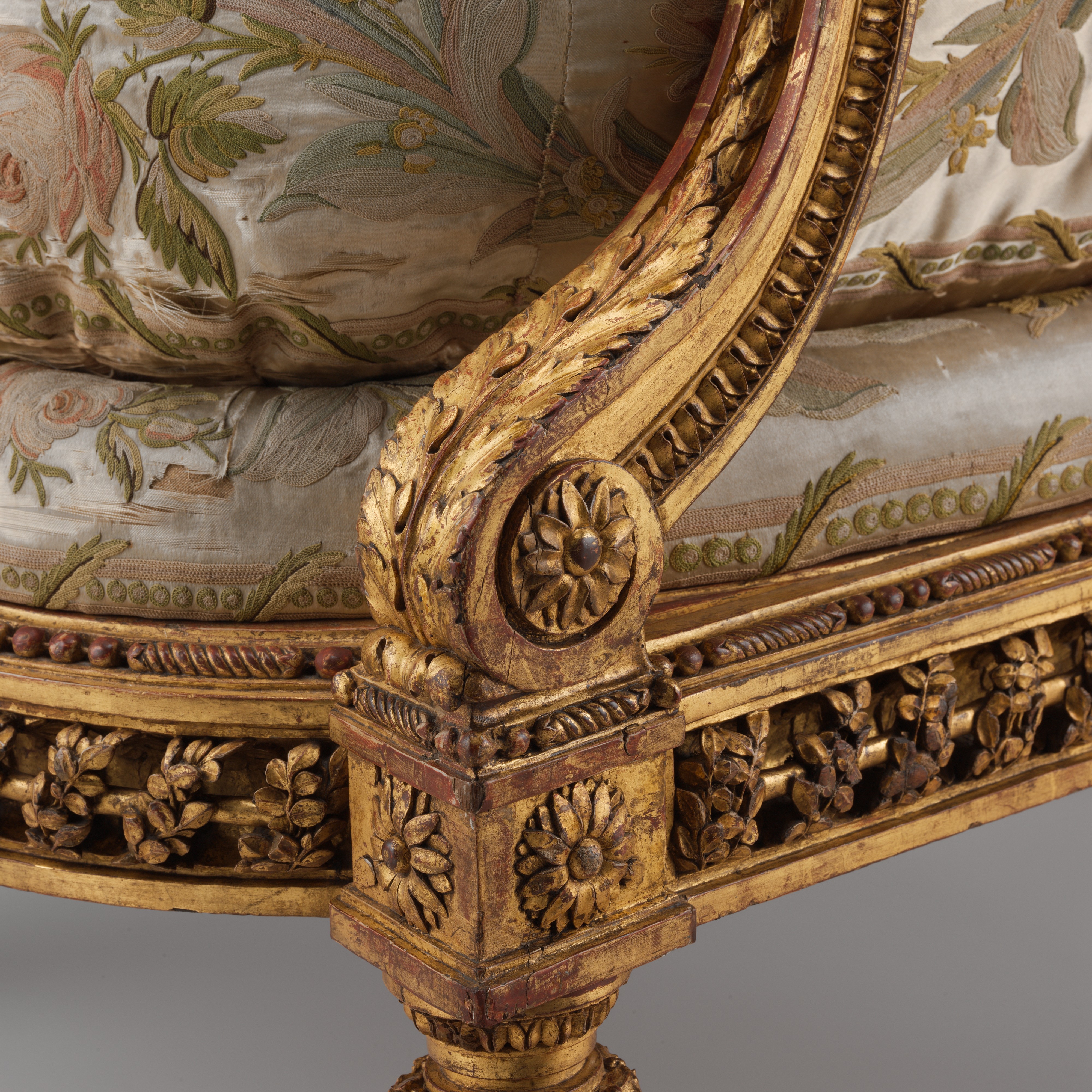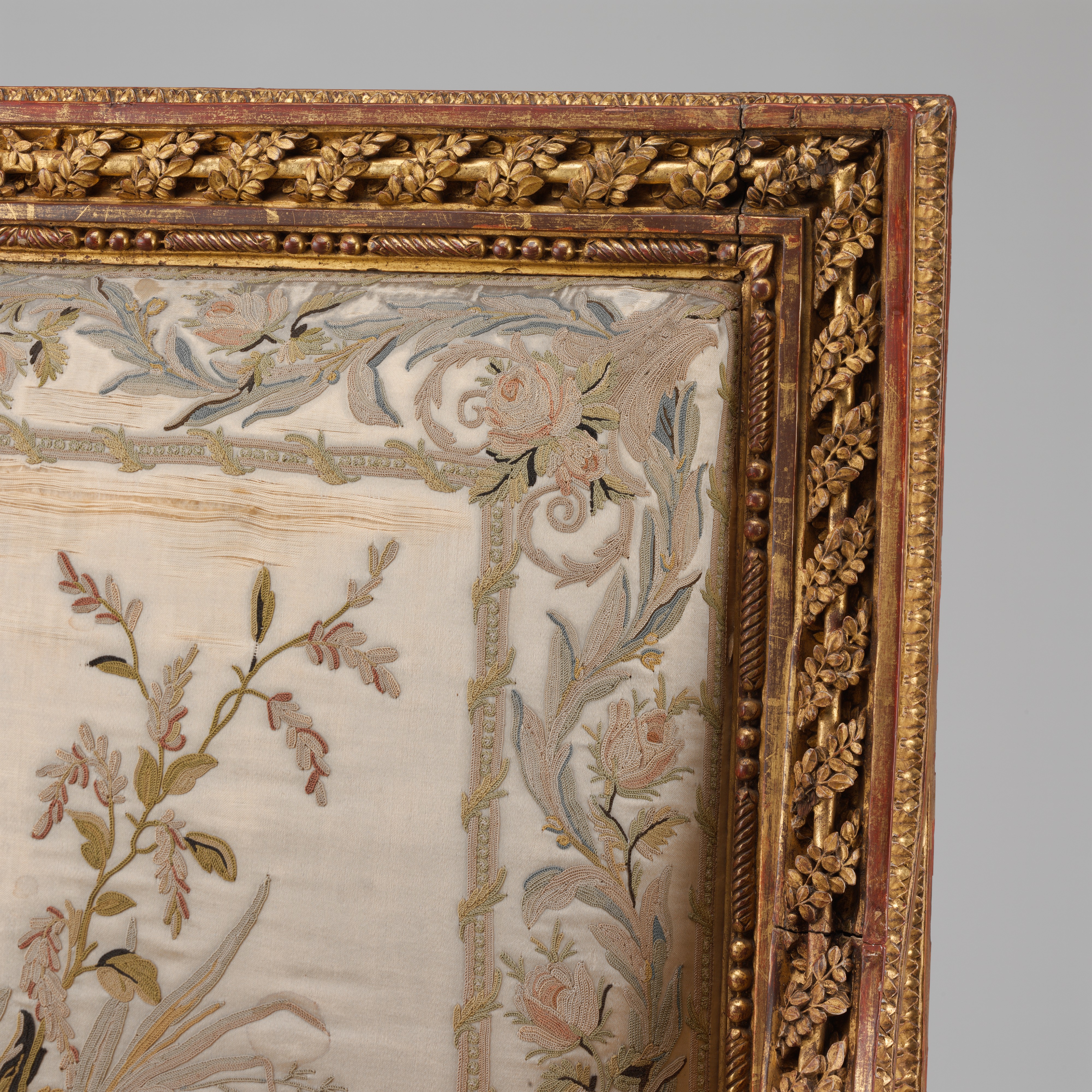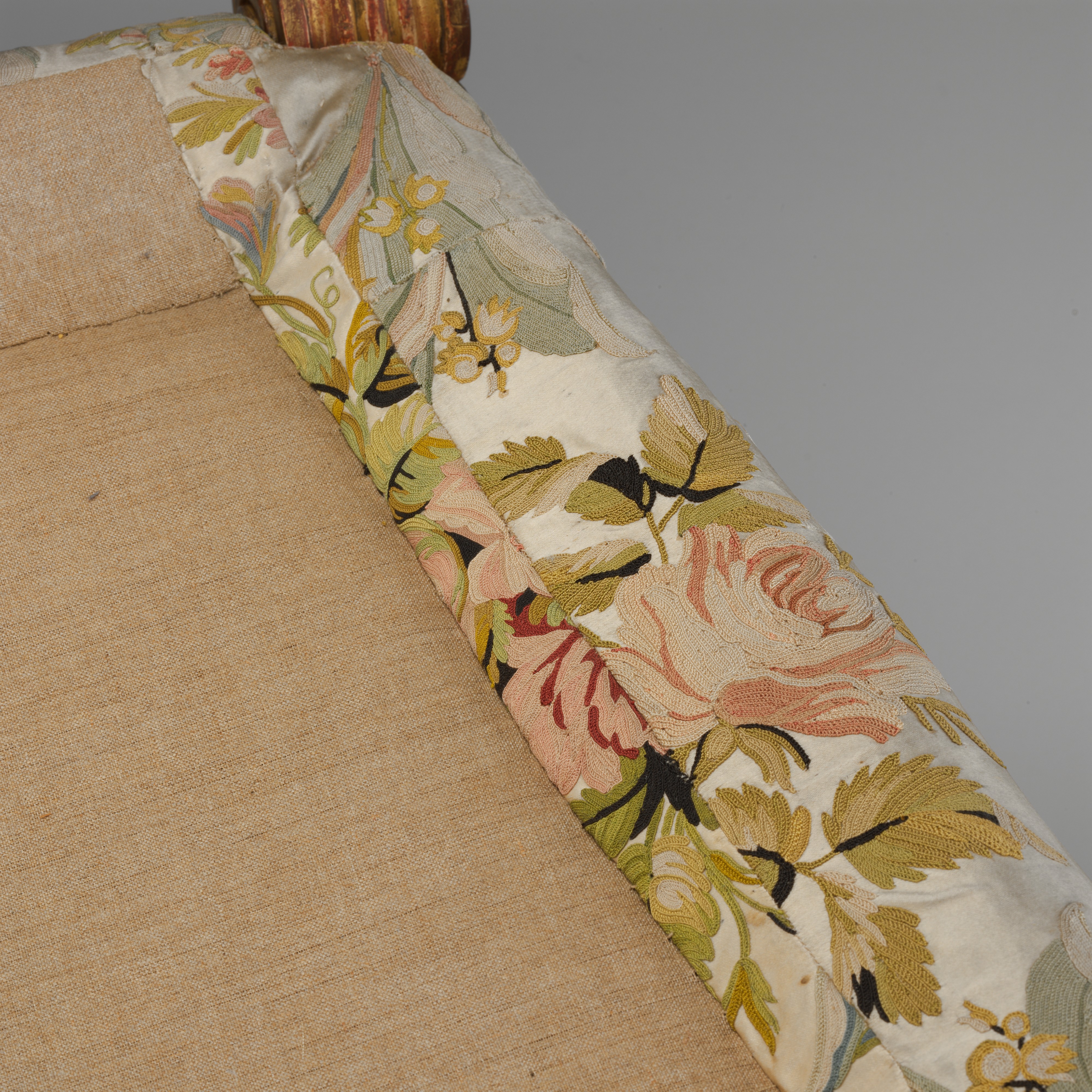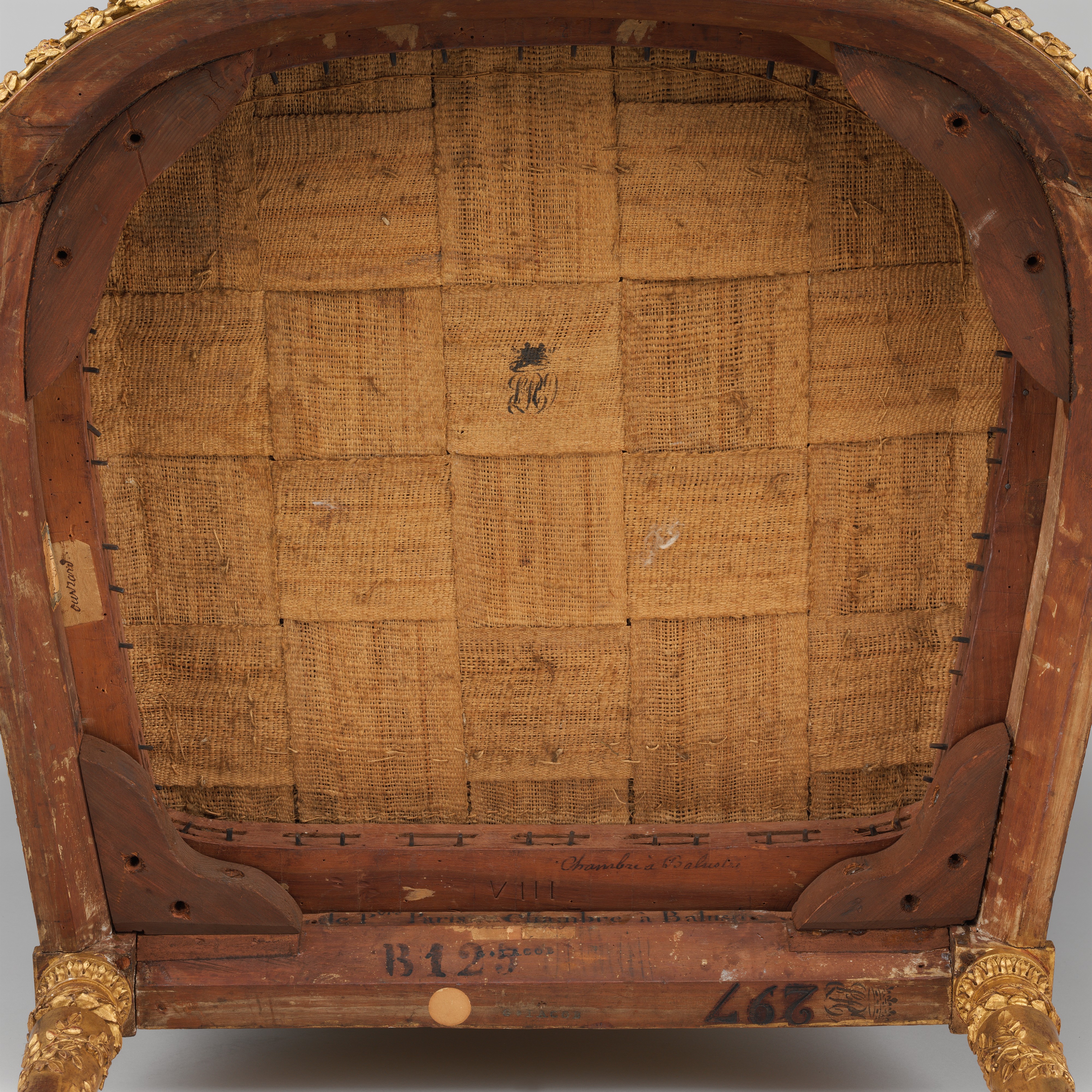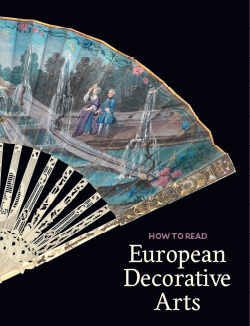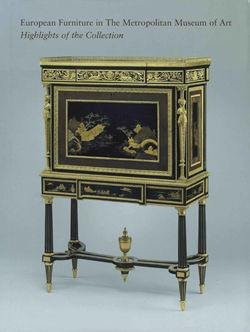Armchair (Fauteuil à la reine) (one of a pair) (part of a set)
Georges Jacob French
Possibly embroidered by Joseph-François-Xavier Baudoin French
Not on view
On 31 October 1947 Duveen Brothers sold what the firm called "The Marie Antoinette Set" for 180,000 dollars to Samuel H. Kress (1863-1955). [1] It consisted of three embroidered wall hangings and various pieces of matched seat furniture that originally belonged to two different eighteenth-century suites, with the addition of several later pieces. [2] The wall hangings-chain-stitched embroideries in silk on a white silk-satin ground-show musical instruments, birds' nests, baskets of flowers, and sun hats linked together with swags of flowers. The present armchair and an identical example, as well as a pair of side chairs of the same design, have eighteenth-century show covers that were made to match these embroideries. In order to give the group of seat furniture a unified appearance, the remaining pieces were upholstered with portions cut from additional embroidered hangings that were sacrificed for this purpose.
It is not entirely clear how such an illustrious provenance became attached to this assembled lot. When the settee, which dates to the nineteenth century, was published in 1927, nothing was said about its origin except, erroneously, that the eighteenth-century menuisier Georges Jacob had signed it. [3 In 1934, however, the author of a book on French furniture stated that the set had been made by Jacob for Marie Antoinette (1755-1793), and described it as "one of the most beautiful examples of the talent of this master." [4] Furthermore, he declared that the embroidery was the work of the queen and her ladies and that Marie Antoinette gave the entire set to Louis-Jean-Marie de Bourbon, duc de Penthièvre (1725-1793). [5]
Stamped by Georges Jacob, who supplied much furniture to the court of Louis XVI (1754-1793), this armchair and its pair have straight, rectangular backs, which characterize them as fauteuils à la reine. When cutting the walnut frames, Jacob must have carefully taken into consideration the planned decoration, leaving enough wood to allow the unidentified but obviously very skilled carver to execute the designs. Particularly striking are the deeply undercut garlands of myrtle branches spiraling around a straight rod on the seat and back rails. Trails of berried myrtle branches are carved around the tapering shafts of the cylindrical legs, which are crowned by collars of laurel leaves and berries. Laurel leaves are also repeated on the front of the curving arm supports that terminate in acanthus-leaf volutes. A molding of pearls and twisted-rope motifs carved along the top of the seat rail gives a rhythmical effect not unlike that created by brass upholstery nails-here absent because the chairs are covered à châssis. The original slip seat and webbing have been preserved.
The back panel, edge roll, arm pads, and comfortable down and feather seat cushion are all covered in the original late-eighteenth-century embroidered silk-satin. [6] The back displays floral branches framed by scrolling floral borders. The seat cushion shows a basket of flowers within similar borders. Certain motifs, such as the band of pearls along the fore edge of the seat as well as along the borders of the cushion and of the back, clearly relate to the carving of the wooden frame. The high quality of the once very colorful chain-stitched embroidery clearly identifies it as professional work rather than as the fruit of the queen's pastime. The elegant floral compositions are close to designs by the famed silk manufacturer Philippe de Lasalle (1723-1804/5).
From a series of marks, inscriptions, and inventory numbers on the frames of both armchairs a considerable amount of information can be gleaned. [7] First of all, the incised roman numerals VII and VIII indicate that they were numbers seven and eight of a suite that included both arm- and side chairs, and possibly one or more settees. It was not unusual for a chairmaker to identify the various elements, especially such removable parts as slip seats and arm pads, as belonging to a certain chair, to avoid mixing them up.
The French inscription "de P[enthiè]vre Paris Chambre à Balus[tre]" (and a variation of this) is enlightening as well, showing that the chairs were in the possession of the wealthy duc de Penthièvre, grand admiral of France and a cousin of Louis XVI. The set furnished his Paris residence, the Hôtel de Toulouse, an early-seventeenth-century building on the rue de la Vrillière, near the place des Victoires. By 1719 the architect Robert de Cotte (1656-1735) had renovated the mansion for the duc de Penthièvre's father, the comte de Toulouse.[8] The hôtel had, according to a late-eighteenth-century description, a chambre des balustres, or room with balustrade on the ground floor. [9] Used only on special occasions, this room was a chambre de parade, or ceremonial bedchamber. A curving balustrade, or estrade, seen in a plan by Jacques-François Blondel (1705-1774), closed off a bed alcove separating the state bed from the rest of the room . [10] To have such a balustrade was a privilege, allowed only in the state apartments of dukes, princes, and grands seigneurs. [11] The formal nature of the Museum's armchairs as so-called fauteuils meublants, placed along the wall and considered to be part of the interior decoration, reflects the official function of the room. Given the various other French inscriptions on the frames, it is possible that the chairs were also used in a different part of the house. It has been suggested that the entire set was placed in the first-floor apartment of the duke's widowed daughter-in-law, Marie-Thérèse-Louise, princesse de Lamballe (1749-1792), a friend of Marie Antoinette's. [12]
After the duc de Penthièvre's death his only surviving daughter, Louise-Marie-Adélaïde de Bourbon-Penthièvre (1753-1821), inherited his possessions. Married to the liberal Louis-Philippe-Joseph, duc d'Orléans (1747-1793), who renounced his title and became known as Philippe-Égalité, she was widowed when he was guillotined during the Reign of Terror in 1793. She was exiled from France, and her property including the Hôtel de Penthièvre (Toulouse) was confiscated in 1797. The chairs may then have come into the possession of the banker Gabriel-Julien Ouvrard (1770-1846), whose name is written on stickers affixed to the slip seats. Having amassed a huge fortune in war speculations, Ouvrard became purveyor to the French navy in 1798. He apparently acquired several of the confiscated estates of the Orléans family that were, however, returned to them in 1814. The "B125" marks on the chairs probably refer to one of these properties, perhaps the eighteenth-century Château de Bizy, in Normandy, where the duc de Penthièvre died and his daughter lived after her return from exile.
An inventory of the Château de Bizy described the Salon de Famille as furnished with hangings of white silk-satin embroidered with floral designs, and it listed a large set of seat furniture in the same room that was upholstered to match. This inventory was drawn up shortly after 1830, when the castle was in the possession of the son of Philippe-Égalité, Louis-Philippe (1773-1850), duc d'Orléans, who became king of France in 1830.The crowned, interlaced monogram "LPO" on the chairs clearly refers to his ownership, and he may have been responsible for uniting the two sets. It has been said that Louis-Philippe left the assembled seat furniture to his youngest daughter, Marie-Clémentine (1817-1907), who lived in Austria after her marriage to Prince Augustus of Saxe-Coburg. [13] Some years after her death, in September 1913, Duveen Brothers, the well-known antiques dealership with branches in London, Paris, and New York, acquired this set of furniture. [14]
Notes:
1. Duveen Brothers Records 1876-1981, Papers and Correspondence, 1901-81, box 475, f. 5 (microfilm, reel 330).
2. In 1958 the pieces were a gift of the Samuel H. Kress Foundation to the Museum. They included two armchairs (acc. nos. 58.75.25,26) and two matching side chairs (58.75.33,34) all stamped by Georges Jacob. There were also two similar armchairs (58.75.30,31) and one small settee, or marquise (58.75.27), also by Jacob but part of another set. In addition, there were a settee (58.75.24), two armchairs (58.75.29,32), and a second marquise (58.75.28) executed at a later date to match the design of accession numbers 58.75.27,30,31. The wall hangings have the accession numbers 58.75.35-37. See Dauterman, Parker, and Standen 1964, pp. 61-75, nos. 7-9.
3. Feulner 1927, p. 675, fig. 600. In this publication the settee is said to be owned by Duveen Brothers.
4. "une des plus belles manifestations du talent de ce maître"; Theunissen 1934, pp. 89-90, pls. XXXIII, XXXIV. In this publication the set is said to be property of Duveen.
5. footnote: Ibid., pp. 89-90. This provenance was supposedly based on a mémoire of Princesse Marie-Clémentine, daughter of King Louis-Philippe, who inherited the set in the nineteenth century.
6. Dauterman, Parker, and Standen 1964, pp. 70, 74, no. 9.
7. The markings on the matching armchair are very similar to those on the present example. Stamped on the underside of the back seat rail are "G+JACOB" twice and "279"; stenciled are "B125" and the crowned monogram "LPO." Inscribed in ink on a sticker pasted under the back seat rail is "Chambre à Coucher." Incised on the top of each seat rail under the slip seat is the roman numeral VII. Painted on the back rail of the slip seat is "No 7 Chambre . . . Balustre en haut," and pasted there is a sticker on which is written in ink "Ouvrard." The webbing is stenciled with the crowned monogram "LPO." There is a torn Duveen Brothers sticker and another with the number 265818 inscribed on it underneath the left side seat rail.
8. Blondel 1752-56, vol. 3, chap. 7, p. 27; and Parker 1960, pp. 296-301.
9. Thiéry 1787, vol. 1, col. 304.
10. Blondel 1752-56, vol. 3, chap. 7, pl. I.
11. Havard 1887-90, vol. 1, col. 234.
12. Dauterman, Parker, and Standen 1964, p. 66, no. 7a-d.
13. footnote: Theunissen 1934, p. 89.
14. footnote: Duveen acquired a one-third share in the set. Duveen Brothers Records 1876-1981, Business Records, 1876-1964, Paris Stock Book, no. 4, 1913-14, box 100, f. 49 (microfilm, reel 35). The set stayed with Duveen until 1947 and is regularly listed in the records. The Marie Antoinette provenance appeared for the first time in 1935; Duveen Brothers Records 1876-1981, Business Records, 1876-1964, box 26, f. 9 and f. 10 (microfilm, reel 11). I am grateful to Charlotte Vignon, Annette Kade Art History Fellow, 2005-2006, Metropolitan Museum, for this information.
Due to rights restrictions, this image cannot be enlarged, viewed at full screen, or downloaded.
This artwork is meant to be viewed from right to left. Scroll left to view more.
